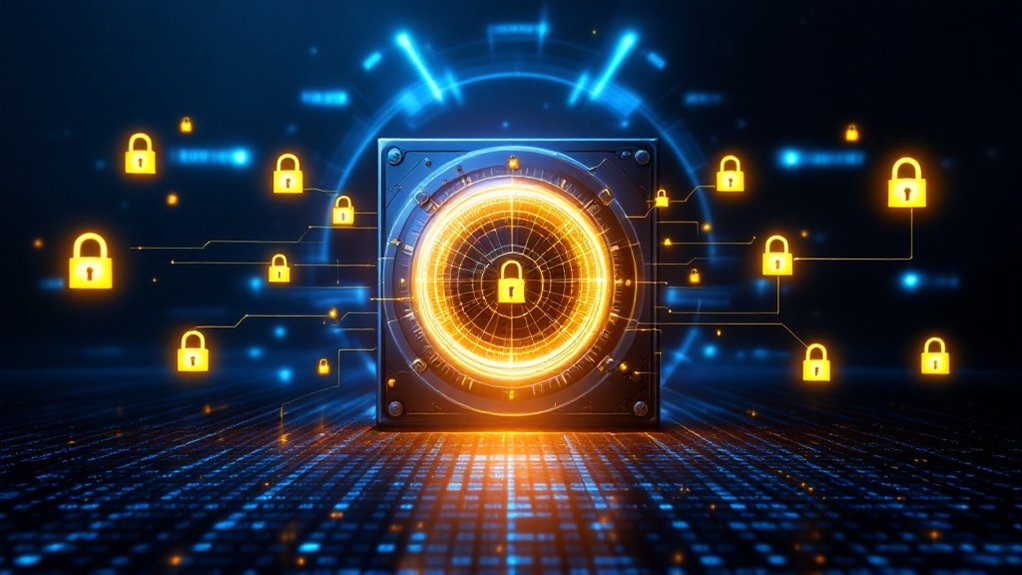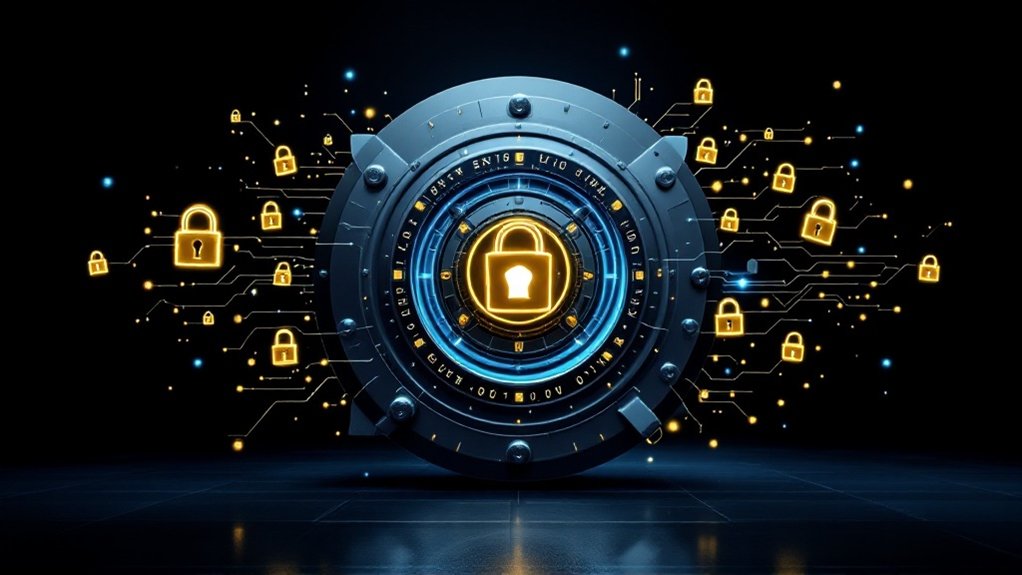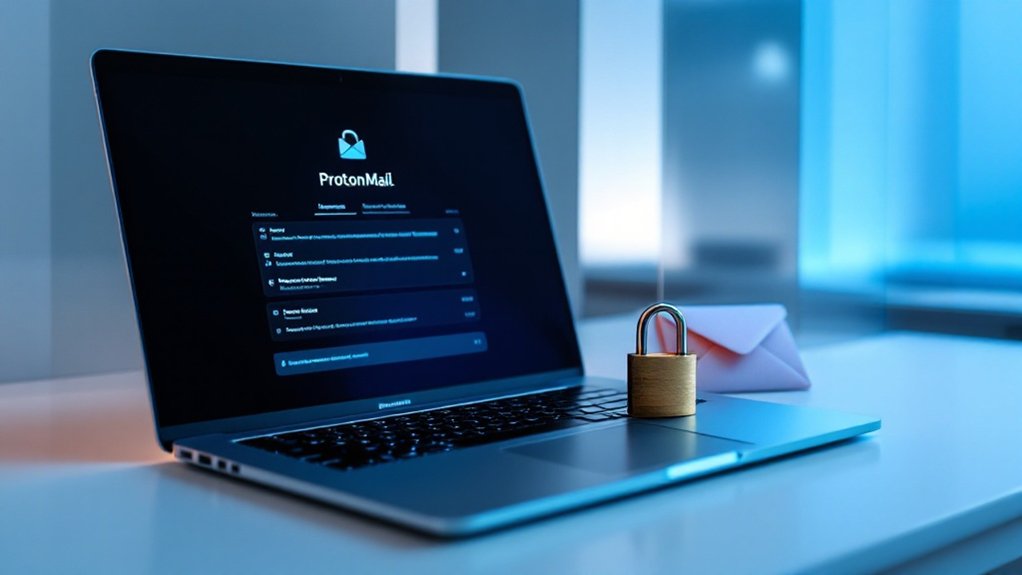LastPass protects online accounts through military-grade AES-256 bit encryption and PBKDF2-SHA256 password hashing with 600,000 iterations. The platform generates complex passwords, stores credentials in an encrypted vault, and implements multi-factor authentication for improved security. Users access their secure vault through a master password, whereas the system provides real-time dark web monitoring and phishing protection. The platform’s thorough Security Dashboard offers deeper insights into maintaining ideal digital security across all accounts.

LastPass stands at the forefront of online security through its extensive password management system, which deploys military-grade AES-256 bit encryption to protect users’ sensitive data. The platform implements PBKDF2-SHA256 with 600,000 iterations, guaranteeing that master passwords remain secure through local encryption and hashing, as well as keeping unencrypted data entirely separate from LastPass servers.
The system generates unique, complex passwords for each user account, incorporating letters, numbers, and special characters to maximize security. These credentials are stored in an encrypted vault, accessible across multiple devices and browsers, requiring the master password for decryption. Regular security audits ensure the ongoing integrity and safety of the platform. The platform’s Secure Notes feature enables safe storage of sensitive information like financial records and personal documents.
LastPass creates robust passwords with diverse characters, storing them securely in an encrypted vault that unlocks with your master password.
The automatic synchronization feature guarantees that users maintain consistent access to their credentials across all devices, including offline accessibility when necessary. The phishing protection feature helps users avoid fraudulent websites by automatically detecting suspicious login attempts.
LastPass streamlines the login process through its advanced autofill capabilities, automatically populating credential fields on matching websites and securing payment information and sensitive data in encrypted notes. This automation considerably reduces the risk of keylogger attacks that could capture manually typed passwords, boosting overall security during daily internet usage.
The platform’s thorough security features include real-time dark web monitoring, which actively scans for compromised credentials and alerts users to potential data breaches.
This proactive approach allows immediate password changes for affected accounts, maintaining the integrity of users’ digital presence. Moreover, LastPass implements strong multi-factor authentication options, including biometric verification and the LastPass Authenticator app, providing improved protection against unauthorized access attempts.
Through its Security Dashboard, LastPass offers users a centralized view of their password health and overall security posture. The system evaluates password strength, identifies vulnerable credentials, and provides actionable recommendations for enhancement.
This all-encompassing approach to password management, combined with continuous monitoring and advanced encryption protocols, establishes LastPass as an essential tool in maintaining digital security across multiple online platforms and services.
Frequently Asked Questions
What Happens to My Passwords if Lastpass Experiences a Server Outage?
During LastPass server outages, users retain full access to their passwords through local encrypted vaults stored on their devices.
The offline functionality allows continued use of browser extensions and mobile apps, with cached credentials remaining accessible without an internet connection.
When connectivity resumes, any changes made during the outage automatically synchronize across devices, as distributed server infrastructure minimizes disruption risks through redundant data storage.
Can I Share My Lastpass Vault With Family Members Securely?
LastPass Families facilitates secure password sharing among up to 6 family members through encrypted vaults and shared folders.
Users can share individual passwords or entire folders as they maintain personal vault privacy, with the capacity to control access permissions and revoke sharing.
The platform’s zero-knowledge security model guarantees shared credentials remain encrypted, allowing family members to access shared items without exposing plain text passwords or compromising individual vault security.
How Does Lastpass Handle Password Recovery if I Forget My Master Password?
LastPass offers multiple password recovery methods when users forget their master password. The primary options include receiving password hints via email, using Recovery One Time Passwords stored in browser extensions, and SMS recovery if pre-configured.
Mobile users with biometric authentication allowed can reset their master password using fingerprint or facial recognition.
Account reversion to previous master passwords remains available within a 30-day window, though LastPass cannot directly reset or retrieve master passwords because of zero-knowledge encryption.
Does Lastpass Work Offline When There’s No Internet Connection?
LastPass provides offline functionality through its vault caching system, allowing users to access their stored passwords without an internet connection.
This feature requires prior account access and explicit enabling through Account Settings.
During offline use, the vault operates in read-only mode, preventing new entry creation.
Security measures include local data encryption, TOTP authentication, and optional passwordless login, though cached data presents potential risks if devices are compromised.
Can I Export My Passwords From Lastpass to Another Password Manager?
LastPass users can export their password data through both the browser extension and web vault interfaces.
The platform offers two primary export formats: an unencrypted CSV file for universal compatibility and an encrypted LastPass format for secure transfers.
The export process requires master password authentication and can be initiated through Advanced Options.
After export, users can import their data into alternative password managers, including popular options like JumpCloud.









